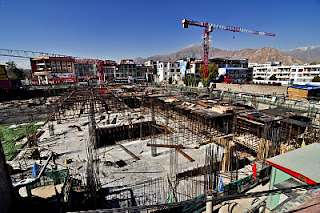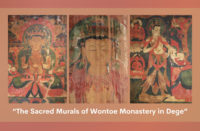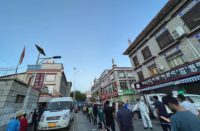High Peaks Pure Earth has translated a blogpost by Woeser written on November 15, 2011 for the Tibetan service of Radio Free Asia and posted on her blog on November 18, 2011.
Lhasa is a subject matter that has been both a source of inspiration and a matter of deep concern for Woeser, as this post demonstrates.


“Lhasa is Being Ruined By Various Gluttonous Ghosts”
By Woeser
When I returned to Lhasa in 2010, I noticed a gigantic shopping centre being built at the margins of the old town; it was called “Spiritual Power Plaza”. Tibetans told me that this “masterpiece” was a collaboration between the authorities and the industry, which meant that it really was a “spiritual power property” exploited by Wenzhou merchants and the children of high officials. I felt sad, the world-famous old town of Lhasa was drawn into irreversible ruin by various gluttonous ghosts.
The entire old town is being commercialised at the hands of influential officials. In the north and north-west of Jokhang Temple we already find two massive department stores that exceed the temple in height; I heard that some mayor, some boss, some “pro-Tibet cadre” had their fingers in this pie. Before, the Jokhang Temple was under the big illusionary umbrella of UNESCO and relied on its reputation as a “world heritage”, which enabled it to at least struggle to maintain its traditional central position, but it is obvious that this is no longer of any use.
From the outside, “Spiritual Power Plaza” that claims to be “Lhasa’s commercial landmark”, resembles Beijing’s Sanlitun Village, occupying 30 mu of land, being four storeys in height with two underground floors, including a car park. Simply thinking about this makes me feel uncomfortable, this huge monster that is completely incompatible with the surrounding landscape will entirely destroy Lhasa’s age-old historical scenery. From advertisements on the internet I found out that among the shops inside will be KFC, Bread Talk, Ajisen Ramen, Levis, JEEP; ONLY etc., not few just being copied from modern metropolises.
In order to build the underground car park, groundwater had to be extracted for which they specially laid out eight or nine thick pipelines, which ran across half of Lhasa and were visibly exposed in the streets. This process had been going on for over a year; every day these pipelines pumped out water, reportedly several thousands of tons per day and the work is not finished yet (2011).
According to historical records, formerly, Lhasa used to be a vast marsh, referred to Skyid-Shod-Vo-Thang with a lake in its centre. 1300 years ago, under the leadership of sovereign king Songtsen Gompo, Tibetan people filled in the lake with earth and built the Jokhang Temple. Until the present day, there exists a hollow pillar near the wall of the central Buddhist Hall of Jokhang Temple; because of the story of a lake existing underneath the temple, when believers put their ears near the hollow pillar, they can still hear the faint rushing of the water. I interviewed an old citizen of Lhasa who recalled that when he was young and went to Jokhang Temple to pay homage to Buddha he could see the underground water pond. This shows that there used to be plenty of groundwater.
Everyone in Lhasa already feels anxious about this. Many residents reported to the relevant authorities the dangers that lie in the extraction of groundwater for the building of the “Spiritual Power Plaza”, but the answer they got was that construction work should not stop, on the contrary, it should be continued at an even greater pace, mentioning only one sentence, “so as to reduce the effects this has on the surrounding geological environment”. This clearly shows that they know exactly that this does indeed “have effects on the surrounding geological environment”. In May 2011, a crack was discovered on Tsomonling Road, approximately 1.2 metres in length. Recently, the Tengyeling district experienced two water cuts of one and four hours; local residents said that these were directly related to the extraction of groundwater.
The younger residents of Lhasa started losing their patience, appealing on Weibo that such large-scale extraction of groundwater will likely result in the cracking of roads, serious subsidence and even the emergence of sinkholes. Furthermore, within a radius of about 1500 metres from the area, we find the Potala Palace, Jokhang Temple, Ramoche Monastery and many other ancient buildings, if the ground subsides it will cause an irreparable loss, relics that have thousands of years of history will be destroyed and Lhasa will be faced with severe water shortage. There are also some text messages circulating stating that Lhasa residents will gather for a protest in the “Spiritual Power Plaza” basin on December 3, 2011 at 10 am.
Yet, large-scale protests are difficult to put into action in today’s Lhasa that is heavily guarded and surrounded by soldiers. Even individual petitions or appeals to the higher authorities are considered as political action and hence suppressed. But people’s dissatisfaction cannot be restrained. Seeing Tibetan people’s holy land of belief, their spiritual home and cultural centre being swallowed up and brought to the brink of ruin by those gluttonous ghosts who claim to have “spiritual power”, how can anyone who loves Lhasa not feel extremely anxious?
A western expert who over ten years ago voluntarily engaged in the restoration of old Lhasa and was thus deported by the authorities, expressed his grievance in an email to me: “Water is a huge issue in Tibet because they are building hydroelectric power plants everywhere. Also, Lhasa’s environment has already been severely damaged and polluted; greedy developers with the support from greedy government officials have made Lhasa’s rivers and valleys resemble a big factory. If Lhalu starts to dry out, well then everything is already too late.”
November 15, 2011









Pingback: “Lhasa is Being Ruined By Various Gluttonous Ghosts” By Woeser « Tibetan Blog Station
Hello,
I am living in Quebec, Canada. I never had the chance to go in Tibet, which is for me, one of the most sacred place on this planet, a sanctuary of wisdom. I hoped all my life having the opportunity to go to your country, how would be possible not having that desire…
Now, i am looking sometimes to some pictures showing what the chinese autorities did to your land, your culture and above all to your people. I can only say, with the deepest and sincere feeling from all my being; i am sorry, sorry, sorry, sorry, sorry, sorry, forever.
I feel so powerless in front of such horrors, I just don’t understand. I can’t understand, i can’t accept this, it’s making me sick, sick.
I try to meditate as often as I could, asking to Universal Forces helping. And many people i know are doing the same now.
I will continue, I think it’s the best I can do to help.
Michel Laramee
Huntingdon, Quebec, Canada
Just Brutal. My wife and I were lucky enough to travel to Lhasa in the ’90’s before the rail line was built and before the nearly one thousand discotech’s and brothels. The rail line allowed for building materials to be brought in, in such large quantities, I fear there is no end. Lhasa will look like every other Chinese grey concrete jungle. So sad, so sad, so unbelievably sad…
Not good
This is just obvious colonization. When you look at the pictures you can see the Chinese language has a prominent place. Tibetan is hardly to be seen, showing very clearly whom these projects are supposed to benefit.
Pingback: High Peaks Pure Earth – The Most-Read Postings on High Peaks Pure Earth in 2012
Pingback: High Peaks Pure Earth – “Our Lhasa is on the Verge of Destruction! Please, Save Lhasa!” By Woeser